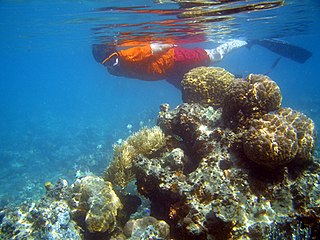
Snorkeling is the practice of swimming face down on or through a body of water while breathing the ambient air through a shaped tube called a snorkel, usually with swimming goggles or a diving mask, and swimfins. In cooler waters, a wetsuit may also be worn. The snorkel may be an independent item or integrated with the mask. The use of this equipment allows the snorkeler to observe the underwater environment for extended periods with relatively little effort, and to breathe while face-down at the surface.

A dry suit or drysuit provides the wearer with environmental protection by way of thermal insulation and exclusion of water, and is worn by divers, boaters, water sports enthusiasts, and others who work or play in or near cold or contaminated water. A dry suit normally protects the whole body except the head, hands, and possibly the feet. In hazmat configurations, however, all of these are covered as well.

The butterfly is a swimming stroke swum on the chest, with both arms moving symmetrically, accompanied by the butterfly kick along with the movement of the hips and chest. It is the newest swimming style swum in competition, first swum in the early 1930s and originating out of the breaststroke.

Breaststroke is a swimming style in which the swimmer is on their chest and the torso does not rotate. It is the most popular recreational style due to the swimmer's head being out of the water a large portion of the time, and that it can be swum comfortably at slow speeds. In most swimming classes, beginners learn either the breaststroke or the freestyle first. However, at the competitive level, swimming breaststroke at speed requires endurance and strength comparable to other strokes. Some people refer to breaststroke as the "frog" stroke, as the arms and legs move somewhat like a frog swimming in the water. The stroke itself is the slowest of any competitive strokes and is thought to be the oldest of all swimming strokes.
Human swimming typically consists of repeating a specific body motion or swimming stroke to propel the body forward. There are many kinds of strokes, each defining a different swimming style or crawl.

Swimfins, swim fins, diving fins, or flippers are finlike accessories worn on the feet, legs or hands and made from rubber, plastic, carbon fiber or combinations of these materials, to aid movement through the water in water sports activities such as swimming, bodyboarding, bodysurfing, float-tube fishing, kneeboarding, riverboarding, scuba diving, snorkeling, spearfishing, underwater hockey, underwater rugby and various other types of underwater diving.
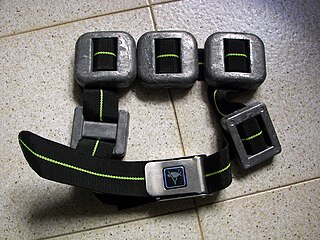
A diving weighting system is ballast weight added to a diver or diving equipment to counteract excess buoyancy. They may be used by divers or on equipment such as diving bells, submersibles or camera housings.

A monofin is a type of swimfin typically used in underwater sports such as finswimming, free-diving and underwater orienteering. It consists of a single or linked surfaces attached to both of the diver's feet, emulating the fluke of Cetaceans like whales or porpoises. Even though the diver's appearance might be reminiscent of a mermaid or merman, monofin swimming is not the same as mermaiding.
The flutter kick is a kicking movement used in both swimming and calisthenics.

Sidemount is a scuba diving equipment configuration which has scuba sets mounted alongside the diver, below the shoulders and along the hips, instead of on the back of the diver. It originated as a configuration for advanced cave diving, as it facilitates penetration of tight sections of cave, allows easy access to cylinder valves, provides easy and reliable gas redundancy, and tanks can be easily removed when necessary. These benefits for operating in confined spaces were also recognized by divers who conducted technical wreck diving penetrations.
A silt out or silt-out is a situation when underwater visibility is rapidly reduced to functional zero by disturbing fine particulate deposits on the bottom or other solid surfaces. This can happen in scuba and surface supplied diving, or in ROV and submersible operations, and is a more serious hazard for scuba diving in penetration situations where the route to the surface may be obscured.
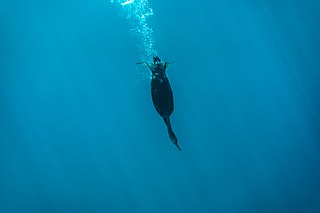
Aquatic locomotion or swimming is biologically propelled motion through a liquid medium. The simplest propulsive systems are composed of cilia and flagella. Swimming has evolved a number of times in a range of organisms including arthropods, fish, molluscs, amphibians, reptiles, birds, and mammals.

Certain species of fish and birds are able to locomote in both air and water, two fluid media with very different properties. A fluid is a particular phase of matter that deforms under shear stresses and includes any type of liquid or gas. Because fluids are easily deformable and move in response to applied forces, efficiently locomoting in a fluid medium presents unique challenges. Specific morphological characteristics are therefore required in animal species that primarily depend on fluidic locomotion. Because the properties of air and water are so different, swimming and flying have very disparate morphological requirements. As a result, despite the large diversity of animals that are capable of flight or swimming, only a limited number of these species have mastered the ability to both fly and swim. These species demonstrate distinct morphological and behavioral tradeoffs associated with transitioning from air to water and water to air.
The Lunocet is a biomimetic monofin intended to reduce drag and augment human swimming ability underwater. It is modeled after a dolphin's tail, by replicating the geometry, scale, and morphology dynamics of what the manufacturer calls the "lunate tail propulsor," as the shape is similar to a crescent moon. During the COVID-19 pandemic, the manufacturer stopped producing the Lunocet due to supply issues.
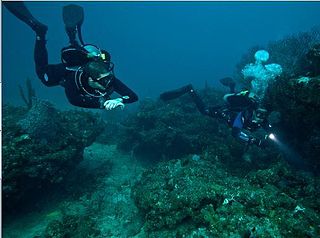
The trim of a diver is the orientation of the body in the water, determined by posture and the distribution of weight and volume along the body and equipment, as well as by any other forces acting on the diver. Both static trim and its stability affect the convenience and safety of the diver while under water and at the surface. Midwater trim is usually considered at approximately neutral buoyancy for a swimming scuba diver, and neutral buoyancy is necessary for efficient maneuvering at constant depth, but surface trim may be at significant positive buoyancy to keep the head above water.

Scuba skills are skills required to dive safely using self-contained underwater breathing apparatus, known as a scuba set. Most of these skills are relevant to both open-circuit scuba and rebreather scuba, and many also apply to surface-supplied diving. Some scuba skills, which are critical to divers' safety, may require more practice than standard recreational training provides to achieve reliable competence.

Doing It Right (DIR) is a holistic approach to scuba diving that encompasses several essential elements, including fundamental diving skills, teamwork, physical fitness, and streamlined and minimalistic equipment configurations. DIR proponents maintain that through these elements, safety is improved by standardizing equipment configuration and dive-team procedures for preventing and dealing with emergencies.
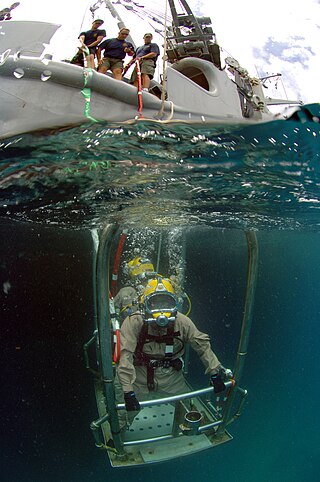
The following outline is provided as an overview of and topical guide to underwater diving:
Low impact diving is recreational scuba diving that is intended to minimise environmental impact by using techniques and procedures that reduce the adverse effects on the environment to the minimum that is reasonably practicable for the situation. To a large extent this is achieved by avoiding contact with sensitive reef life, but it also applies to diving on historical wrecks and in caves with delicate rock formations. It is in the interests of diving tourism service providers to help protect the condition of the dive sites on which their businesses rely. They can contribute by encouraging and teaching low impact diving and following best-practice procedures for diving in sensitive areas. Low impact diving training has been shown to be effective in reducing diver contact with the bottom, the most common cause of reef damage.

Human factors in diving equipment design are the influences of the interactions between the user and equipment in the design of diving equipment and diving support equipment. The underwater diver relies on various items of diving and support equipment to stay alive, healthy and reasonably comfortable and to perform planned tasks during a dive.

















